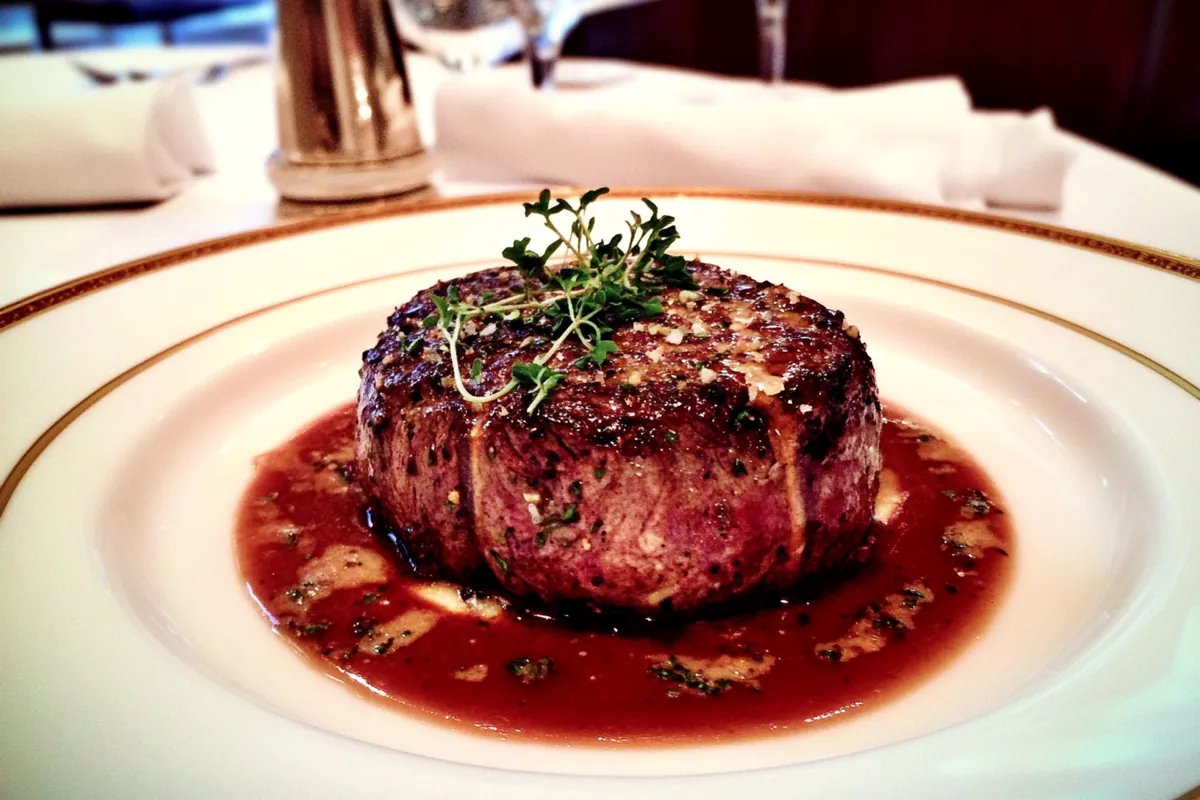Filet mignon is a term that evokes thoughts of exquisite dining and culinary pleasure. But what does filet mignon mean in French? Understanding this term opens the door to a deeper appreciation of French cuisine and its traditions. In this article, we will explore the meaning, translation, pronunciation, and cultural significance of filet mignon, along with its place in culinary arts. So, let’s dive in!
Table of Contents
Understanding Filet Mignon
To truly grasp what filet mignon means, it helps to start with a clear definition.
Definition of Filet Mignon
Filet mignon refers to a specific cut of beef that comes from the tenderloin. It’s one of the most prized cuts due to its tenderness and rich flavor. The name itself suggests a certain elegance, often associated with fine dining experiences.
Origin of the Term ‘Filet Mignon’
The term filet mignon originates from French, where “filet” means “thick slice” or “fillet,” and “mignon” translates to “dainty” or “small.” This highlights the cut’s delicate nature and small size. The usage of these terms dates back to the 19th century, solidifying its status as a luxury item in French gastronomy.
Culinary Significance in French Cuisine
Filet mignon holds a prominent spot in French cuisine. It is often prepared with precision and skill, typically grilled, pan-seared, or roasted. Chefs value this cut for its ability to absorb flavors, making it a popular choice for various sauces and accompaniments. The dish frequently appears on upscale restaurant menus, showcasing French culinary artistry. For those wanting to explore more about meat cuts, you can read about the differences between filet mignon and other cuts.
Filet Mignon mean in French and Translation
Understanding the translation of filet mignon sheds light on its significance.
Literal Translation of ‘Filet Mignon’
When translating filet mignon, it directly translates to “dainty fillet.” This description emphasizes both its finesse and the care taken in preparing it. The literal translation highlights the cut’s reputation as a refined and luxurious option in the culinary world.
What Does Filet Mignon Mean Literally?
Breaking down the translation further, “filet” points to a cut of meat, while “mignon” implies something small and delicate. Thus, the term conveys the essence of a tender, high-quality piece of meat that is delightful to eat. This combination of words perfectly captures the allure of this dish.
Filet Mignon Pronunciation
Another important aspect of filet mignon is how to pronounce it correctly.
How to Pronounce ‘Filet Mignon’
The pronunciation of filet mignon can be challenging for non-French speakers. It is pronounced as “fee-lay mee-nyon.” Emphasizing the second syllable of “filet” and ensuring a soft ‘nyon’ sound for “mignon” is crucial for proper delivery.
Common Mispronunciations
Many people may mispronounce filet mignon in various ways, such as “fillet mini-on” or “filet myon.” Such mispronunciations can lead to confusion, especially in dining situations. It’s essential to practice the correct pronunciation to ensure you communicate effectively about this exquisite dish.

The Anatomy of Filet Mignon
Filet mignon is not just any cut of meat; it has a unique structure that makes it stand out. Understanding its anatomy helps in appreciating why this cut is so sought after.
Cuts of Meat That Include Filet Mignon
Filet mignon specifically comes from the tenderloin, which is a long, narrow muscle located along the spine of the cow. This muscle does very little work, which contributes to its extraordinary tenderness. The tenderloin is divided into several parts, and filet mignon is cut from the smaller end. This cut is typically about two inches thick and can weigh between six to eight ounces. Because of its tenderness, filet mignon is often considered the best cut of beef for grilling or pan-searing.
If you want to know more about the various types of beef cuts, you can explore how filet mignon compares to other cuts of beef here.
Differences Between Filet Mignon and Other Cuts
While filet mignon is renowned for its tenderness, it is essential to understand how it differs from other popular cuts. For example, ribeye steak is known for its rich marbling and flavor, making it a favorite among those who prefer a bolder taste. On the other hand, sirloin is a leaner cut that is less tender but more affordable.
In contrast, filet mignon’s tenderness comes from its low-fat content, making it an exquisite choice for those who enjoy a melt-in-your-mouth experience. This cut also absorbs marinades and sauces exceptionally well, enhancing its flavor profile. Whether grilled, broiled, or baked, filet mignon offers a unique culinary experience that sets it apart from other meat cuts.
Filet Mignon mean in French Culture
Filet mignon is not just a dish; it is a significant part of French culture. Its presence in French cuisine reflects the country’s love for quality ingredients and meticulous cooking techniques.
Popularity in French Restaurants
In France, filet mignon is a staple on many restaurant menus. French chefs pride themselves on their ability to prepare this cut to perfection. Often served with rich sauces like béarnaise or a red wine reduction, filet mignon embodies the elegance of French dining. Its popularity extends beyond restaurants as it is frequently prepared in homes, especially for special occasions.
Moreover, the influence of French cuisine has made filet mignon a beloved dish worldwide. Many people associate this cut with fine dining, making it a go-to choice for celebratory meals. If you’re interested in exploring how filet mignon is served in various French dishes, you might find the traditional recipes fascinating.
Traditional Recipes Featuring Filet Mignon
Filet mignon can be prepared in numerous ways, showcasing its versatility. A classic French dish is filet mignon au poivre, where the steak is coated with crushed peppercorns and served with a creamy sauce. Another favorite is filet mignon en croûte, a preparation where the filet is wrapped in puff pastry and baked, offering a delightful contrast of textures.
These traditional recipes highlight not only the cut’s tenderness but also its ability to pair beautifully with various flavors and ingredients. The preparation and presentation often reflect the artistry of French cuisine, making it a true culinary delight.
How to Cook Filet Mignon
Cooking filet mignon requires some technique, but the results are well worth the effort. This cut is best when cooked to medium-rare, allowing its natural flavors to shine.
Best Cooking Methods for Filet Mignon
There are several methods to cook filet mignon, each bringing out its unique qualities. Grilling is a popular option, as it enhances the steak’s flavor with a smoky char. Alternatively, pan-searing gives a delicious crust while keeping the inside tender. Sous vide is another method that ensures perfect doneness by cooking the steak in a water bath at a precise temperature.
For those who are adventurous in the kitchen, trying the sous vide method can be rewarding. This technique allows for consistent cooking, ensuring that the filet mignon retains its juiciness and tenderness. If you’re interested in sous vide cooking, check out our guide on the ultimate sous vide techniques.
Tips for Perfecting the Filet Mignon
To achieve the best results, consider the following tips:
- Season Generously: Use salt and pepper to enhance the natural flavors of the beef. Feel free to experiment with herbs and spices.
- Let It Rest: After cooking, allow the filet mignon to rest for a few minutes. This helps redistribute the juices, making it more flavorful.
- Use a Meat Thermometer: To ensure perfect doneness, use a meat thermometer. Aim for an internal temperature of about
What is Filet Mignon Called in France?
In France, filet mignon is known by the same name, though it may be prepared and served in various styles that reflect regional culinary traditions. Understanding the terminology used can enhance your dining experience.
Regional Variations of Filet Mignon
While the term “filet mignon” is used throughout France, different regions may have their own specialties that highlight this cut of beef. For example, in the southwestern regions, filet mignon might be served with a sauce made from local ingredients, such as mushrooms or truffles. In contrast, coastal regions may pair this cut with lighter sauces or fresh herbs.
Moreover, some regions might emphasize the use of specific cooking methods. For instance, in Provence, you may find filet mignon grilled over open flames, imparting a delicious smoky flavor. These regional variations showcase the versatility of filet mignon, making it a beloved choice across the country.
Terms Used in French Butcher Shops
When shopping for filet mignon in a French butcher shop, you might encounter variations in terminology. While filet mignon generally refers to the cut from the tenderloin, you may also hear terms like tendre de filet or filet de bœuf. Each term emphasizes the quality and tenderness of the beef, ensuring that customers are aware of the premium cut they are purchasing.
Understanding these terms can help you navigate French menus and butcher shops with ease. It can also enhance your ability to communicate your preferences when ordering or purchasing meat.
Exploring the Meaning of ‘Mignon’
The word mignon carries significance beyond its use in filet mignon, connecting to the broader themes of French culture and cuisine.
What is the Meaning of the French Word ‘Mignon’?
In French, mignon means “cute,” “dainty,” or “small.” This delightful term can apply to various contexts, from describing a charming dessert to a tender piece of meat. Its usage in filet mignon aligns perfectly with the cut’s characteristics. The term reflects a sense of delicacy and refinement, which is why filet mignon is often celebrated in upscale dining.
This notion of cuteness or daintiness enhances the appeal of filet mignon as a luxurious dining option, conveying the idea that it is not just about taste but also about the overall dining experience.
Why is it Called ‘Mignon’?
The use of the word mignon in the context of filet mignon highlights the cut’s tenderness and small size. It suggests that this piece of meat is a choice cut, deserving of special attention. This naming convention emphasizes the care and skill involved in preparing and serving such a delicate dish.
Furthermore, the association of mignon with quality and elegance has contributed to its prominence in fine dining. Chefs and diners alike appreciate the attributes that this word conveys, making filet mignon a staple in gourmet cuisine.
Filet Mignon in Popular Culture
Filet mignon has transcended the culinary world, becoming an icon of luxury and indulgence in popular culture.
Filet Mignon in Movies and Literature
Filet mignon often appears in films and literature as a symbol of fine dining and celebration. Characters in films frequently enjoy this elegant dish during special occasions, highlighting its status as a luxury item. This portrayal reinforces the idea that filet mignon is not just food; it is an experience tied to moments of joy and festivity.
For example, in various romantic comedies, a dinner featuring filet mignon often sets the stage for significant character interactions. These scenes underscore the connection between food and relationships, emphasizing the role of gourmet cuisine in creating memorable experiences.
Celebrity Chefs and Filet Mignon
Many celebrity chefs have popularized filet mignon through their cooking shows and cookbooks. For instance, renowned chefs often showcase their unique preparations of this cut, introducing viewers to new flavors and techniques. This exposure has solidified filet mignon’s place in American culinary culture as well.
Furthermore, restaurants led by these chefs frequently feature filet mignon on their menus, enhancing its allure and making it accessible to a broader audience. By promoting this dish, celebrity chefs help sustain the tradition of high-quality dining experiences.

Conclusion and Final Thoughts
In summary, understanding what filet mignon mean in French enriches our appreciation of this exquisite dish. From its delicate definition to its cultural significance, filet mignon represents the pinnacle of culinary artistry. As we’ve explored, this cut is not only about flavor but also about the experience it offers, whether enjoyed at a fine restaurant or prepared at home.
As you venture into the world of French cuisine, let filet mignon be a dish that highlights your culinary journey. Embrace its elegance, savor its tenderness, and enjoy the rich flavors that come with this delightful cut of beef. If you’re inspired to try cooking filet mignon, consider exploring various recipes that celebrate its unique characteristics.
FAQ
As with any beloved dish, filet mignon often generates curiosity and questions. Here, we address some common inquiries related to this exquisite cut of beef.
What is Filet Mignon Called in France?
In France, filet mignon is called the same name. However, it’s important to note that different regions may have their own specialties and variations when preparing this cut. French restaurants and butcher shops might also use terms like tendre de filet or filet de bœuf to describe it. Understanding these terms can enhance your culinary experience and help you navigate menus with confidence.
What Does Filet Mignon Mean Literally?
Literally, filet mignon translates to “dainty fillet” in English. This translation reflects both the cut’s tenderness and its smaller size compared to other beef cuts. The term emphasizes the delicate nature of the meat, making it a popular choice for upscale dining experiences. This delicate interpretation is vital to understanding why filet mignon is considered a luxurious option.
What is the Meaning of the French Word ‘Mignon’?
The French word mignon means “cute,” “dainty,” or “small.” In the context of filet mignon, it highlights the cut’s tender and refined quality. This term conveys a sense of elegance, suggesting that this cut of meat is not just about flavor but also about the overall dining experience. The usage of mignon reinforces the idea that filet mignon is a special treat, deserving of admiration.
Why is it Called ‘Mignon’?
The term mignon is used in filet mignon to emphasize the cut’s tenderness and delicate nature. The naming signifies that this piece of meat is a high-quality choice, reflecting the care taken in its preparation. This connection between the name and the qualities of the dish contributes to its reputation in fine dining, making filet mignon a symbol of luxury and culinary excellence.




